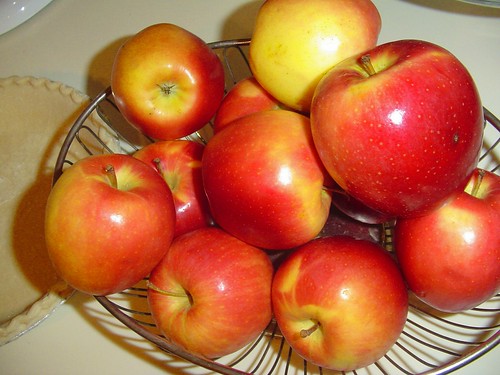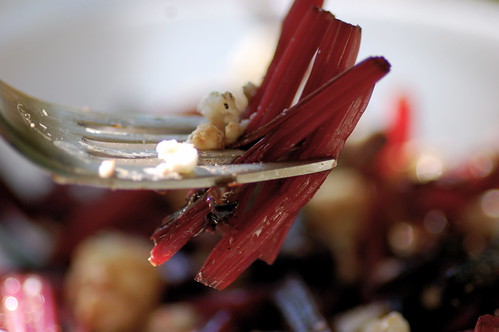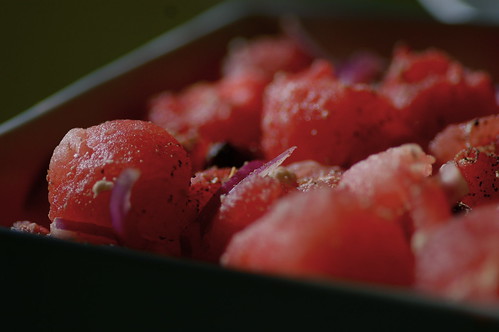You may be wondering if this is strictly a vegetarian recipe site. It's not. Patrick and I were both raised in Texas, where BBQ brisket is ubiquitous. Somewhat reluctantly, I've helped process a deer and make homemade venison sausage. I still swoon at the smell of bacon, which conjures up childhood memories of fresh crisp waffles. As I've gotten older, I've given up meat from time to time. Patrick really is a pescetarian - as he'll occasionally fold (once every few months) for sashimi at our favorite sushi place in Andersonville. I knew he didn't eat meat and when we moved in together. While he was never militant about it, I just never really brought it into the house. It's sort of a pain to cook for one, so I never ate it at home. Over time, the habitual consumption of meat was simply replaced with healthier alternatives in our house.
Many times friends turn up their noses at the idea of a vegetarian meal. I assure you, though, that there are so many vegetarian food options that you'll never really miss the meat. I'm not a big fan of meat analogs (I prefer the real thing or nothing), and have to admit that my health has vastly improved since I've cut meat out of my diet. And, as an added bonus eating meat-free is substantially cheaper and lets me splurge on the things that I truly love like good wine and cheese. I may be able to give up meat completely, but I just can't give up cheese. No offense to my vegan friends. Let's just say it's a good thing I live so close to Wisconsin.
Here's a great recipe for veggie burritos that utilize nopales. Ingredients not pictured: jarred jalapenos (and juice), chipotle tabasco, a can of Meijer's refried beans with lime, shredded colby jack cheese, spices for the guacamole and flour tortillas.
While most people are familliar with the majority of these ingredients, I wanted to include information about the nopale or nopalito - as I know a lot of people pass by them in the produce section because they're afraid of what they will taste like or simply don't know what to do with them. For those of us that don't eat meat nopalitos impart a hearty meaty texture that is usually only a function of a soy derivative. While you can buy the individual prickly pear leaves, it's much easier to just buy the processed, chopped product usually sold in little baggies. My local grocer doesn't carry them - but every Latin grocer I've visited has them freshly in stock.
Here's information from wiki about nopales (often referred to as nopalitos when already processed and cut around here).
--
Nopales are a vegetable made from the young stem segments of prickly pear, carefully peeled to remove the spines. They are particularly common in their native Mexico. Farmed nopales are most often of the species Opuntia ficus-indica, although the pads of almost all Opuntia species are edible.
Nopales are generally sold fresh or canned, less often dried to prepare nopalitos. They have a light, slightly tart flavor, and a crisp, mucilaginous texture.
Nopales are commonly used in Mexican cuisine in dishes such as huevos con nopales (eggs with nopal), or "tacos de nopales". Nopales are also an important ingredient in New Mexican cuisine, and are gaining popularity elsewhere in the United States.
Nopales are very rich in insoluble and especially soluble dietary fiber. They are also rich in vitamins (especially vitamin A, vitamin C, and vitamin K, but also riboflavin and vitamin B6) and minerals (especially magnesium, potassium, and manganese, but also iron and copper). Nopales have a high calcium content, but the nutrient is not biologically available because it is present as calcium oxalate, which is neither highly soluble nor easily absorbed through the intestinal wall.
Addition of nopales also reduces the glycemic effect of a mixed meal.
------
To make delicious veggie burritos, thinly slice a sweet red pepper and one third of a red onion. Heat a grill pan (a skillet with raised grill embedded) on medium heat and spray lightly with olive oil. Put the pepper and onion over in the pan over medium heat. Add 8 oz. of sliced baby bella mushrooms, and cook about 5 minutes or until the vegetables start to soften and the onions become lightly translucent. Add diced dethorned nopales and cook for 2 minutes or so. Add one diced tomato and a handful of fresh organic spinach. In a separate pan, heat the refried beans. Add a few tablespoons of jarred jalapeno juice to the sizzling vegetables. Drizzle some chipotle tabasco over the vegetables. Smear a tablespoon or two of the heated beans in the middle of a heated flour tortilla. Spoon in some vegetables, a squeeze of lime, some homemade guacamole, sour cream if you'd like it, a sprinkling of shredded cheese, and tuck in the end and roll it up. You'll never notice there's not any meat in these.













